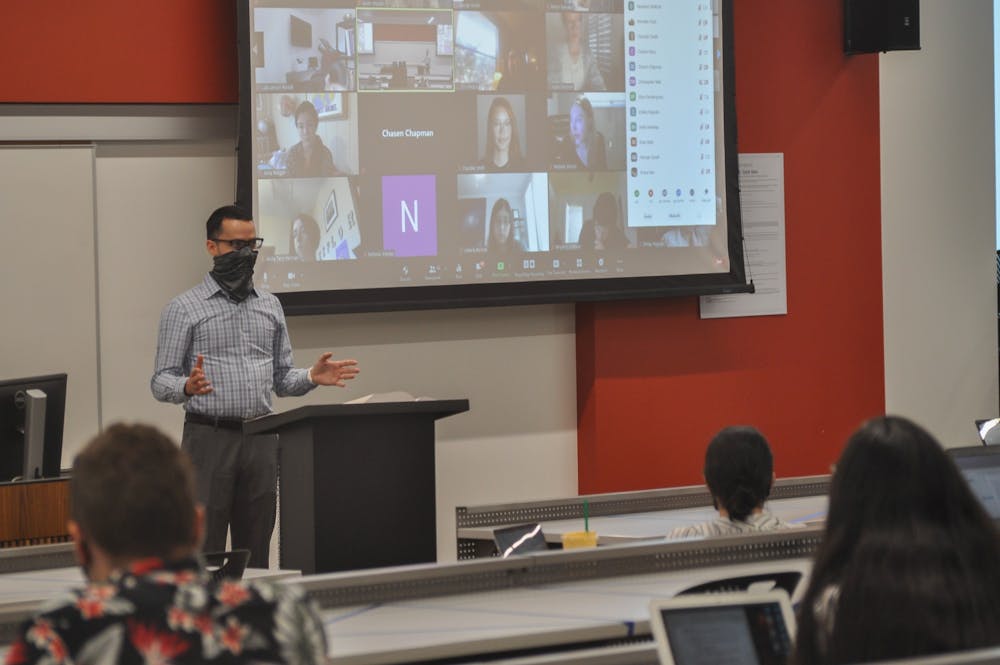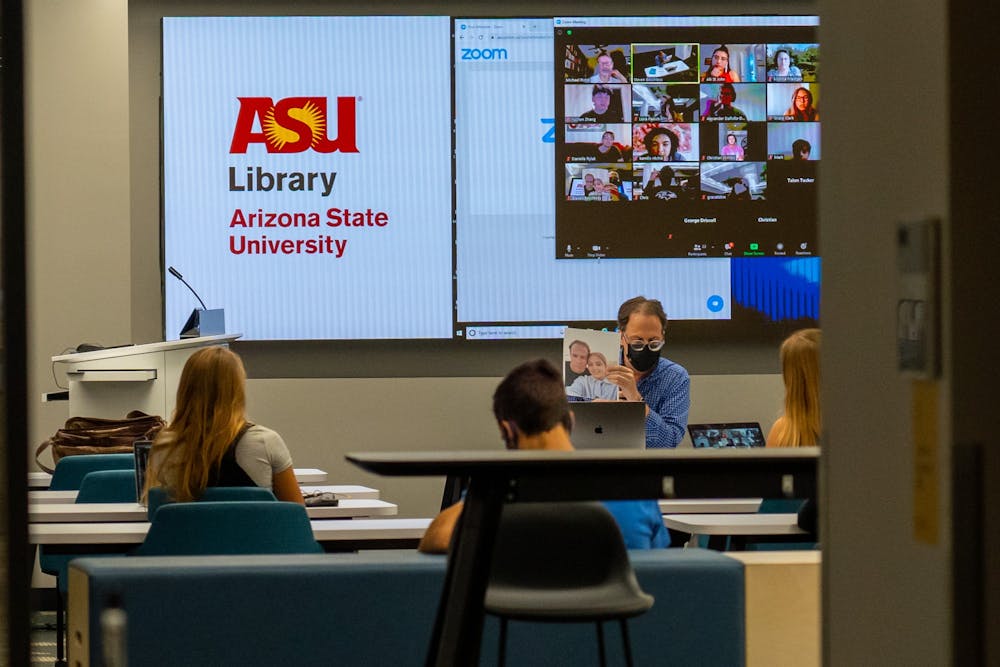When Claire McWilliams returns to her classroom, a lot of little things won't be the same — students studying travel and tourism will be encouraged to bring in more technology, and visiting lecturers will Zoom in from cities and states far away from Arizona.
Students spread out in the space will be encouraged to wear masks. Recorded class sessions and learning materials will be accessible online during the course, all part of McWilliams' plan to get ahead of anything changing on a dime, as what has become customary during the ongoing COVID-19 pandemic.
McWilliams, a full-time faculty member in the School of Community Resources and Development, said the past academic year "was a kind of intense boot camp of what the future of instruction looks like, but it just happened in a very condensed and kind of involuntary way."
And that condensed, involuntary boot camp, McWilliams said, was a "painful process," one that included organizing deadlines on the fly to remain flexible, communicating information in sometimes more than one modality and being present for student needs — personal and academic.
"We all had a traumatizing experience," McWilliams said. "And while humans have traumatizing experiences, we tend to have them at separate times and in secret. This is one that all of us were having at the same time."
After nearly five consecutive semesters in a hybrid environment, most faculty described their colleagues and students to have finally completed a masterclass in resiliency, a word that has been tossed around and carries more than one definition.
"Resiliency is not 'Everything is going to be fine,'" said Frederick Corey, former vice provost for undergraduate education. "Resiliency means 'I acknowledge that what I'm going through right now is very difficult, but I will persevere and I will find a way through it.'"
Though it may take more time to process the amount of stress, fear, grief and uncertainty that permeated the past academic year, faculty of all types hope to use lessons learned from teaching in a pandemic during the upcoming in-person fall semester.
Learning from teaching with technology
Corey, who once oversaw all academic matters related to undergraduate students, said prior to the pandemic, he was attempting to move the University from the "sage on a stage" model to a "flipped classroom," where students learn material on their own and apply it in activities or discussions in class.
Though the flipped classroom model wasn't attainable as COVID-19 kept students from collaborating face-to-face, Corey said "at ASU, there's not much fear of technology, among both students and faculty," and the transition to using Zoom was relatively easy.
While the transition to learning remotely may have been smooth, multiple faculty said they had difficulty deciding which technologies would help them most in class.
Andrew Barnes, a professor of history in the School of Historical, Philosophical and Religious Studies and has been teaching online classes for more than 10 years, said he had students use YouTube as a platform for uploading projects to share with the class, something he had never done before.
Danielle Wallace, a public health and crime researcher as well as an associate professor in the School of Criminology and Criminal Justice, said the "1,001 different ways to get it done" were overwhelming to manage.
"It's fantastic that we have the capability to (do this, but) when those capabilities don't necessarily make it into the hands of faculty and staff, it makes it a missed opportunity," Wallace said.
The abundance of technology, combined with the pandemic, upended many faculty's foundations of classes and forced them to adapt processes to reach core goals.
For McWilliams and several other instructors, designing a course begins and ends with learning outcomes. Once learning outcomes are identified or determined by a department, instructors think of ways students can manifest it best.
Documents such as syllabi act as a contract between instructors and students that communicates those learning outcomes, how much time will be designated to each item and "deliverables that (students) put forth, both large and small," McWilliams said.
Once COVID-19 became a factor, work plans changed significantly. Concepts took longer to grasp, and policies were implemented that had never existed before to accommodate for all sorts of situations.
"Now we know that things can interrupt the process," McWilliams said. "From a more esoteric perspective, we're going to have to look at the changes to education from a bigger picture standpoint. So we need to make sure that it’s modern and applicable, industry and research-relevant."
Corey, now a professor in the College of Integrative Sciences and Arts, said part of the "exciting challenge" in moving the educational needle toward positive change is creating flexible, engaging learning models that embrace technology.
Implementing ASU Sync was meant to provide that flexibility, as it allowed students to pick whether they would take a specific course on campus or over Zoom. In Fall 2020, the modality was used for most of the 14,551 in-person class sections.
READ MORE: What you need to know about ASU's Fall 2021 semester
But as of Aug. 6, ASU will only offer 400 designated ASU Sync courses in Fall 2021, compared to the 15,784 class sections being delivered on campus and in person, according to a University spokesperson.
Support during the pandemic
When so much of life outside the classroom is stressful and unknown, which happens with or without a pandemic, McWilliams said "a teacher who is caring, transparent, full of effort and modeling 'We don't know the answers, but we’re going to find them together'" works well in person and online.
Wallace understands her students are probably desperate to return in person, just like she is. She misses interacting with them and the material at the same time but said because the pandemic still looms, "it would be really important for students to understand that everybody's exhausted, everybody has unique circumstances."
Corey said the same about unique circumstances but added that the premise applied to both faculty and students. He said supporting faculty works best when it comes from academic units, like departments or colleges. He explained some units created "buddy systems" that facilitated "local networks" for talking through stress or getting help with technology.
"Every single person, including our administrators, our president (Michael Crow) and everybody in between was also going through this traumatic experience," McWilliams said. "At the same time, their bandwidth was getting sucked into all these different directions, and so I really felt sometimes it was up to me to just figure it out."
READ MORE: ‘It’s horrifying’: Faculty raise concerns teaching in person as start nears
In addition to buddy systems, Wallace said faculty were asked by department heads to give students "a ton of grace — understand their lives are a mess, understand this is extremely difficult, understand the pandemic is raging and they're facing extreme circumstances."
Corey said it was important to recognize the pandemic took everyone by surprise, and there was no room to second guess students and the challenges they were facing.
Wallace regeared the end of some classes so students were still learning, just without the pressure of needing to create a product or meet yet another deadline. She cut out entire assignments, which allowed her "to attend to their learning process a little bit better," but she said she often felt students didn't give faculty the same kind of grace.
"We became hyper student-focused and we wanted to make sure everybody was doing OK," Wallace said. "But it was an enormous lift for the staff and the faculty members across the University."
Eric Legg, an associate professor in the School of Community Resources and Development, said it was all difficult, but working and learning alongside colleagues made a lot of the stress subside.
They helped him "figure out the puzzle" of teaching through a pandemic and said, "There was never a moment where I didn't feel like they were fully invested, that they cared, that they were doing everything they could to make this as best as possible."
Faculty now look to take what they learned during the pandemic to push their pedagogy forward. Moving "forward is the key," Corey said. The ASU community "can't go back to 2020, and we can't go back to 2019," he said.
The future
Getting back to normal for a lot of students means reacclimating to a face-to-face environment, Corey said. Most students enrolled have had only short periods of time in a "regular" University setting.
READ MORE: Students eager to learn in person as they move into a new ‘normal’
"I think the challenge there is that we all need to watch out for each other," Corey said. "If somebody goes into self isolation, in a way that is not maybe the best option for that person, then we as a community need to say 'Let's take small steps and get back to interpersonal life in a way that's healthy for all of us.'"
Prompted by a question on Reddit, several faculty said there was no option to continue using ASU Sync unless it was pre-approved by the University, a point that a faculty FAQ page confirms. Some faculty said they'd do their best to continue recording and posting lectures for students who miss class.
But McWilliams believes students may need some time to adjust to losing the flexibility they had with the hybrid modality for multiple semesters.
"You can't put the toothpaste back in the tube in terms of student convenience and choice," McWilliams said.
The spokesperson wrote in an email that the University "is developing ASU Sync as a new teaching modality. ... Courses and degree programs are being offered by Sync that have been specifically selected for the pedagogical benefits or learning in that modality."
Wallace, just like McWilliams, said her upcoming classes are ready to go online at any moment. She's recorded homework help videos and has allowed for unlimited practice problems on homework assignments.
While normal is on the horizon, students will likely still engage with the subject of the pandemic in class. In researching the spread of COVID-19 within prisons, incarcerated populations and reentry, Wallace plans to show students results as well as the research process in real-time.
"We're not going to give them COVID fatigue by being myopic about just this moment, but it did force me to look at all my content," McWilliams said.
Reach the reporter at pjhanse1@asu.edu and follow @piperjhansen on Twitter.
Like The State Press on Facebook and follow @statepress on Twitter.
Continue supporting student journalism and donate to The State Press today.

Piper Hansen is the digital editor-in-chief at The State Press, overseeing all digital content. Joining SP in Spring 2020, she has covered student government, housing and COVID-19. She has previously written about state politics for The Arizona Republic and the Arizona Capitol Times and covers social justice for Cronkite News.





